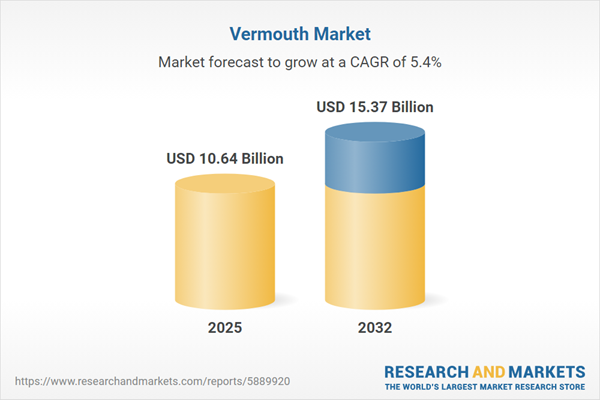Speak directly to the analyst to clarify any post sales queries you may have.
Senior leaders in the beverage sector face significant challenges as they navigate dynamic consumer preferences, regulatory developments, and shifting competitive landscapes. Access to reliable and up-to-date global vermouth market intelligence empowers executive teams to make data-informed decisions that position their organizations for sustained growth and agile adaptation.
Market Snapshot: Global Vermouth Market Size and Outlook
The global vermouth market is on a sustainable upward trajectory, with market value forecasts showing expansion from USD 10.08 billion in 2024 to USD 10.64 billion in 2025, and projected to reach USD 15.37 billion by 2032. The compound annual growth rate (CAGR) is 5.41%. Both on-trade and off-trade channels continue to provide stability as consumer enthusiasm for inventive brands, flexible product formats, and revived cocktail culture enhances competitive energy. As digital transformation intensifies and new companies enter the field, established players are responding by shoring up their market reach and adapting to increasingly diverse industry requirements.
Scope & Segmentation: Comprehensive Global Vermouth Market Analysis
Detailed segmentation offers market leaders the ability to make informed investment choices, mitigate operational risk, and align with evolving industry dynamics. This analysis covers core market segments and provides a clear strategic framework:
- Product Types: Bianco, Dry, Rosso, Rosé, and Sweet cover a range of consumer palates, enabling brands to pursue differentiation and specialized innovation strategies.
- Distribution Channels: Duty Free, E-Commerce, Specialty Liquor Stores, Supermarkets, Bars and Pubs, Restaurants, and Hotels form a comprehensive route-to-market network, supporting omnichannel engagement opportunities.
- Packaging Types: Formats such as 1 L, 375 ml, and 750 ml bottles let companies respond to regional consumption patterns and environmental considerations through targeted packaging strategies.
- Alcohol Content: High, Low, and Standard ABV classes give producers flexibility to cater to both moderation trends and established consumption habits worldwide.
- End Use: Cocktails, Ready-To-Drink, and Straight Consumption signal opportunities to capitalize on new occasions, especially in the hospitality and retail sectors, where multifunctional products hold competitive value.
- Form: Conventional Vermouth and Ready-To-Drink formats highlight the ongoing demand for both classic recipes and convenience-driven innovation.
- Regions Covered: Americas, Europe, Middle East & Africa, and Asia-Pacific present unique regulatory, consumer, and competitive conditions that shape go-to-market strategies regionally.
- Key Market Players: Includes global and regional manufacturers such as Bacardi Limited, Davide Campari-Milano S.p.A., Pernod Ricard S.A., Gruppo Montenegro S.p.A., Distillerie Dolin S.A.S., Giulio Cocchi S.p.A., Gancia S.p.A., Stock Spirits Group plc, Lucas Bols N.V., and Koninklijke De Kuyper Royal Distillers B.V., reflecting a diverse operational landscape.
Key Takeaways for Senior Decision-Makers
- Brands are utilizing advances in botanical blends and prioritizing premiumization to develop distinct offerings tailored to changing consumer interests.
- Greater emphasis on sustainable packaging and increased transparency within supply chains supports compliance and strengthens stakeholder trust.
- Adopting digital-first strategies and direct-to-consumer models allows suppliers to respond to shifting buyer behaviors and enhance customer engagement.
- Localization strategies, such as promoting brand heritage and piloting new product formats, help increase relevance and sharpen brand differentiation across varied markets.
- Expanding product portfolios to include low- and non-alcoholic variants increases access to consumers seeking moderation and caters to emerging global preferences.
- Ensuring robust supplier relationships and flexible distribution networks is crucial for minimizing operational risk, particularly in fluctuating regulatory and supply chain conditions.
Tariff Impact: Navigating Trade Policy Shifts
Recent tariffs on fortified wine imports entering the United States are influencing sourcing structures for vermouth producers. Strengthening local supplier relationships and investing in regional integration have become key practices for insulating operations from trade-related disruptions and ensuring the consistency of market access under changing policies.
Methodology & Data Sources
This analysis is grounded in secondary research supported by structured expert interviews gathered across production, distribution, and market development points. Each conclusion undergoes a thorough peer review to guarantee senior decision-makers benefit from actionable and accurate global vermouth market insight.
Why This Report Matters: Strategic Benefits for Vermouth Market Leaders
- Thorough segmentation and analytic structure support resource allocation and refine market entry strategies across categories, formats, and geographies.
- Actionable insights provide guidance on ESG commitments, support digital evolution, and help leaders anticipate regulatory adjustments efficiently.
- Reliable market intelligence builds stakeholder confidence and supports informed navigation through industry transformation.
Conclusion
This report delivers a structured market overview and strategic intelligence that helps executive decision-makers form resilient responses to industry evolution and capitalize on emerging global vermouth opportunities.
Additional Product Information:
- Purchase of this report includes 1 year online access with quarterly updates.
- This report can be updated on request. Please contact our Customer Experience team using the Ask a Question widget on our website.
Table of Contents
3. Executive Summary
4. Market Overview
7. Cumulative Impact of Artificial Intelligence 2025
Companies Mentioned
The companies profiled in this Vermouth market report include:- Bacardi Limited
- Davide Campari-Milano S.p.A.
- Pernod Ricard S.A.
- Gruppo Montenegro S.p.A.
- Distillerie Dolin S.A.S.
- Giulio Cocchi S.p.A.
- Gancia S.p.A.
- Stock Spirits Group PLC
- Lucas Bols N.V.
- Koninklijke De Kuyper Royal Distillers B.V.
Table Information
| Report Attribute | Details |
|---|---|
| No. of Pages | 188 |
| Published | November 2025 |
| Forecast Period | 2025 - 2032 |
| Estimated Market Value ( USD | $ 10.64 Billion |
| Forecasted Market Value ( USD | $ 15.37 Billion |
| Compound Annual Growth Rate | 5.4% |
| Regions Covered | Global |
| No. of Companies Mentioned | 11 |









